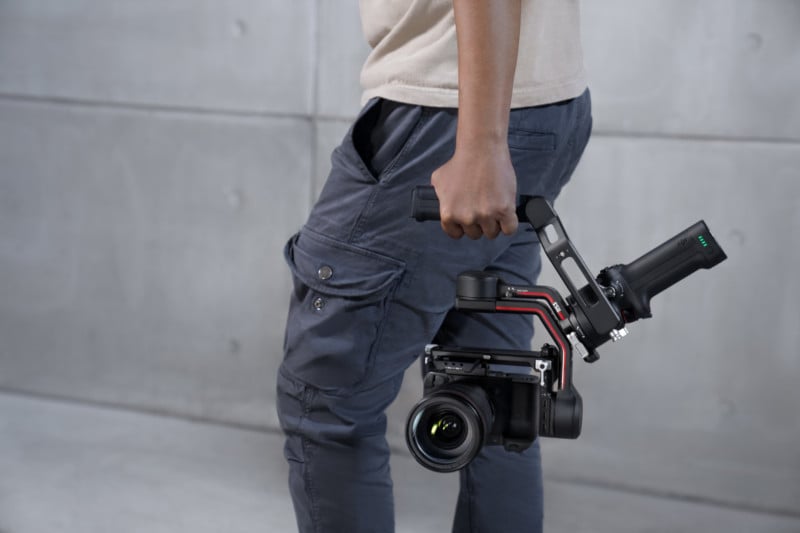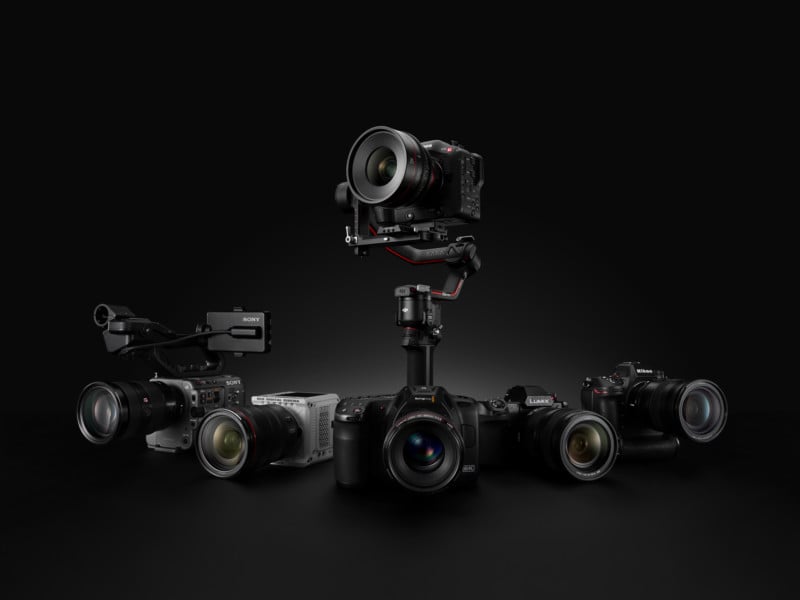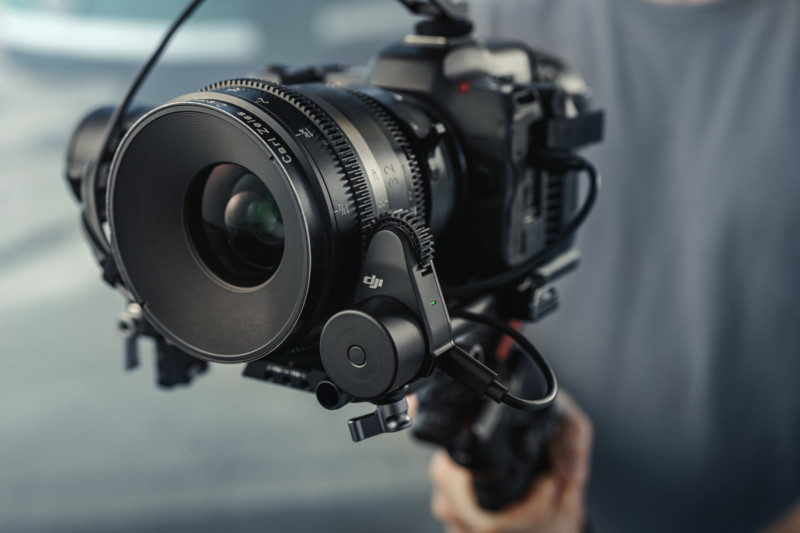DJI’s New RS 3 Pro Gimbal Adds LiDAR AF to Manual Focus Lenses
![]()
DJI has announced the RS 3 and RS 3 Pro gimbals which offer a new automated axis lock system, the third-generation RS stabilization algorithm that improves performance by 20%, and one-tap calibration.
The RS 3 system is available in two tiers, the RS 3 and RS 3 Pro. The RS 3 features improvements that make it faster to set-up and use along with 12 hours of battery life, while the RS 3 Pro brings a suite of features on top including a LiDAR focusing system taken from the DJI Ronin 4D that grants fast autofocus to manual focusing cinema lenses.
The DJI RS 3
The RS 3 weighs 2.8 pounds, which DJI says is light enough to easily be operated with one hand. It has a 6.6 pound tested payload capacity which it says is enough to support the majority of mainstream devices.
DJI touts the RS 3 as having a set of new features that gets filmmakers up and running as quickly as possible. It has a redesigned axes-locking system that makes setup much faster. Once the gimbal is turned on, the axis locks release and unfold the gimbal automatically. Tapping the power button will send the device into sleep mode, which DJI Says makes powering on the device, stowing it away, and relocating much faster.
![]()

The company says the RS 3 removes the need for repetitive balancing with position memory via quick-release plates, which it says enables fast mounting with the perfect balance of the payload. The RS 3 also has a Bluetooth shutter button that supports automatic connection with a camera, which removes the need to connect a cable.
![]()
The third-generation RS Stabilization Algorithm improves the RS 3 over the RSC 2 by 20%, which it says is most visible when the gimbal is used at low angles, while running, or while filming from a moving vehicle. The RS 3 also supports SuperSmooth Stabilization with lenses with focal lengths up to 100mm.
![]()
DJI says the RS 3 is easier to configure thanks to its new 1.8-inch OLED full-color touch screen, which is an increase in working area of 80% compared to the previous generation gimbal. DJI says gimbal setups can be done directly without connecting to the mobile app, while the UI and interface logic have been redesigned to put all controls front and center. This includes a physical gimbal mode switch that operators can slide to alternate between pan follow, pan and tilt follow, and FPV modes instantly.
The RS 3’s new battery provides up to 12 hours of battery life and supports PD fast charging at 18 watts. The battery can also be charged independently or during use.
![]()
The standalone DJI RS 3 is available starting today for $549.
The DJI RS 3 Pro
While the updates to the RS 3 are notable, those who work in even more demanding environments are given the option of the RS 3 Pro.
The arms of the RS 3 Pro are constructed form one piece of uncut carbon fiber which DJI says makes it lighter and stronger than the jointed carbon fiber material used on previous stabilizers. The company says it also extended the arms to allow for more balancing space that is required for professional cameras like the Sony FX6, Canon C70, and RED Komodo.

Additionally, the structure has been optimized to keep its weight at 3.3 pounds with a 10-pound tested payload capability.
![]()
It has the same automated axis locks, Bluetooth Shutter Button, 1.8-inch OLED touchscreen, and gimbal mode switch of RS 3.
What makes the RS 3 Pro really stand out is its ability to turn a manual focus cinema lens into an autofocus lens. The RS 3 Pro has the ability to use the same LiDAR focusing technology found on the Ronin 4D in the DJI LiDAR Range Finder (RS). DJI says this attachment is capable of projecting 43,200 ranging points within a 14-meter indoor area. It combines with a high-torque focusing motor to give manual lenses autofocus capabilities.

DJI says the LiDAR Range Finder carries a DJI-developed chip identical to the one used in Ronin 4D and a built-in 30mm camera that boosts the computing power of ActiveTrack by more than 60 times, creating what it calls ActiveTrack Pro.
![]()
![]()
DJI also says it has target identification and tracking capabilities that are very sensitive and accurate enough to enable professional cameras to maintain a steady, clear shot even in dynamic scenarios.
DJI Transmission
DJI has also developed its first independent wireless video solution that combines reception, monitoring, control, and recording into one.
O3 Pro transmission technology enables the transmission system to offer a 20,000-foot on-ground transmission distance with end-to-end ultra-low latency, which DJI positions as a huge upgrade from traditional WiFi transmission. Video is transmitted in 1080p 60 frames-per-second and provides live audio monitoring at 16-bit 48 kHz.
DJI also added a DFS band on top of the traditional 2.4 GHz and 5.8 GHz settings, which offers 23 channel options that provide crews with more compliant and interference-free transmission channels. A built-in frequency sweeper automatically scans the current electromagnetic environment for the best wireless channel, instantly switching channels when needed. When necessary, users can also manually select an appropriate channel to avoid interference between devices.
![]()
Supporting its new wireless video solution is a seven-inch 1,500-nit bright remote monitor that supports one transmitter with multiple receivers, as well as two transmission modes to address different transmission needs. The monitor has a built-in gyroscopic sensor that acts as a standalone motion controller for the RS 3 Pro and, when combined with the Ronin 4D Hand Grips,, the operator of an RS 3 Pro stabilizer can control the gimbal, focus, exposure, and start/stop a recording with both hands.
![]()
The DJI RS 3 Pro is available starting today for $869. The DJI Transmission Combo is available for $2,499 and includes one DJI Video Transmitter, a DJI High-Bright Remote Monitor, and a host of accessories.